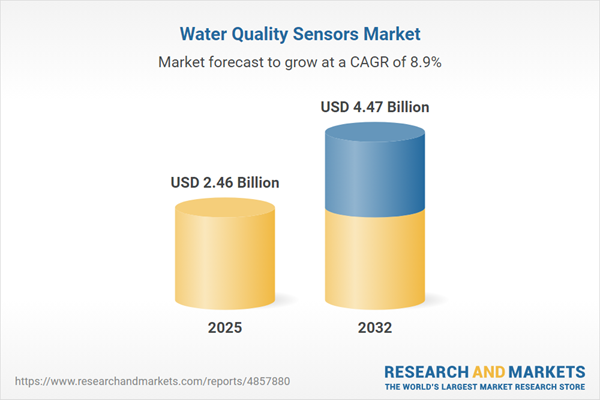Speak directly to the analyst to clarify any post sales queries you may have.
The water quality sensors market is rapidly modernizing as enterprises advance toward smarter water management, efficient regulatory compliance, and enhanced operational visibility. As regulatory focus intensifies and digitalization accelerates, senior decision-makers need actionable insights to lead transformation effectively.
Market Snapshot: Water Quality Sensors Market Overview
The global water quality sensors market is projected to grow from USD 2.26 billion in 2024 to USD 2.46 billion in 2025, representing a CAGR of 8.89%. By 2032, the market size is expected to reach USD 4.47 billion. This expansion is supported by sustained investments in digital monitoring capabilities and the strong pace of digital infrastructure upgrades across diverse sectors. Compliance-focused initiatives and sector-specific standards are driving increased sensor adoption, as manufacturing, utilities, and property management accelerate deployment for improved efficiency, reliable compliance processes, and immediate access to key operational data. Successful navigation of ongoing digital transformation is closely tied to the ability to meet evolving regulatory and technology standards, ensuring long-term organizational agility.
Scope & Segmentation: Core Technologies and Applications in Water Quality Sensors
- Product Type: Laboratory-based water quality sensors deliver high-precision data, supporting rigorous centralized control procedures. These are pivotal in industries such as pharmaceuticals and research laboratories, where quality standards are critical. Portable and handheld sensors offer rapid response and on-site monitoring for distributed teams, enhancing operational agility in environments with variable water conditions.
- Technology: Biosensors are engineered for targeted contaminant detection, enabling sensitive monitoring in both industrial processes and environmentally sensitive sites. Electrochemical sensors are widely implemented in municipal and industrial infrastructure, chosen for their robust and consistent measurement performance. Optical solutions—such as fluorescence, near-infrared, and UV-VIS technologies—address complex analysis requirements in environmental health and public sector water management.
- End User: Commercial operators, manufacturers, and utilities utilize connected water quality sensors to support compliance reporting, ensure effective resource management, and streamline internal processes. Increasing adoption among residential communities points to rising awareness of safety and regulatory best practices at the local level.
- Regional Coverage: Adoption rates are surging across multiple regions, including North America, South America, Europe, Middle East and Africa, and Asia-Pacific. The United States, Germany, Brazil, China, and India are at the forefront of innovation and deployment, due to advanced digital capabilities and sector-specific regulations driving demand for water quality sensors.
- Company Analysis: Leading providers such as Danaher Corporation, Xylem Inc., Thermo Fisher Scientific, Endress+Hauser, ABB, Siemens, Emerson Electric, Honeywell, Horiba, and Yokogawa Electric are prioritizing research, next-generation product development, and strategic collaborations to remain synchronized with evolving standards and application requirements.
Key Takeaways for Senior Decision-Makers
- Deployment of smaller, miniaturized sensors is extending monitoring capabilities to challenging and previously overlooked sites, increasing data collection fidelity and improving real-time incident management across water infrastructures.
- Combining water quality sensors with Internet of Things (IoT) platforms and cloud technologies is centralizing control and analysis, unlocking predictive maintenance strategies and better asset oversight in both urban and remote installations.
- Collaboration between technology manufacturers, standards agencies, and research organizations is fostering the development of unified sensor performance criteria, promoting higher user trust and enabling cross-industry applicability.
- Strategic alignment with regional regulations strengthens overall program effectiveness, reduces the risks from shifting policies, and ensures ongoing compliance for enterprises operating across diverse jurisdictions.
- Adoption of advanced analytics and predictive tools is allowing organizations to proactively respond to regulatory changes, supporting operational continuity and robust long-range water resource management.
2025 United States Tariffs: Market and Supply Chain Impact
- Rising tariffs on water quality sensors and associated components are increasing operational costs, prompting organizations to accelerate automation and diversify sourcing strategies.
- Strengthening supplier partnerships and deploying advanced procurement processes are now priority actions for ensuring consistent supply chains amid shifting trade policies.
- Manufacturers are reassessing product designs and global operations to reduce tariff exposure, safeguarding reliability and service quality across all customer segments.
Methodology & Data Sources
This analysis synthesizes primary interviews with senior industry executives, a careful review of industry research, and detailed patent assessments. Peer review ensures that findings are credible and actionable for executives developing water management strategies.
Why This Report Matters
- Provides the strategic insights senior decision-makers require to direct investments and develop future-ready water quality monitoring solutions.
- Supports the design of robust, adaptable supply chains capable of mitigating risks from regulatory and trade changes, empowering organizations to identify new opportunities.
- Equips leaders with relevant intelligence to benchmark operational practices and improve compliance with quality assurance standards throughout their water management programs.
Conclusion
By prioritizing advanced sensor integration, organizations can effectively maintain compliance and increase operational resilience. Strategic investment supports long-term growth and ensures best practices in water resource management as the market landscape evolves.
Additional Product Information:
- Purchase of this report includes 1 year online access with quarterly updates.
- This report can be updated on request. Please contact our Customer Experience team using the Ask a Question widget on our website.
Table of Contents
3. Executive Summary
4. Market Overview
7. Cumulative Impact of Artificial Intelligence 2025
Companies Mentioned
The companies profiled in this Water Quality Sensors market report include:- Danaher Corporation
- Xylem Inc.
- Thermo Fisher Scientific Inc.
- Endress+Hauser AG
- ABB Ltd.
- Siemens AG
- Emerson Electric Co.
- Honeywell International Inc.
- Horiba Ltd.
- Yokogawa Electric Corporation
Table Information
| Report Attribute | Details |
|---|---|
| No. of Pages | 194 |
| Published | November 2025 |
| Forecast Period | 2025 - 2032 |
| Estimated Market Value ( USD | $ 2.46 Billion |
| Forecasted Market Value ( USD | $ 4.47 Billion |
| Compound Annual Growth Rate | 8.8% |
| Regions Covered | Global |
| No. of Companies Mentioned | 11 |









